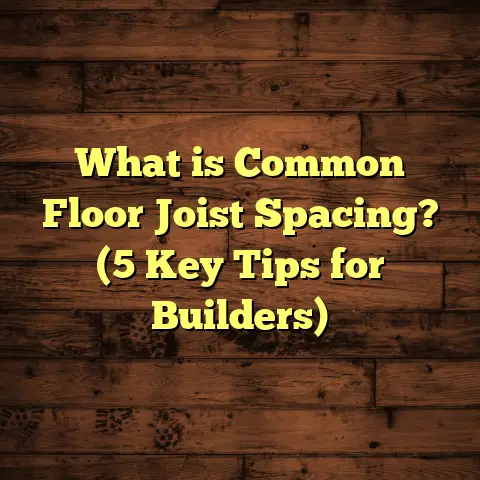What is Flooring Threshold Depth? (5 Essential Tips for Homeowners)
Have you ever walked into a room and immediately noticed how the floor flows—or doesn’t flow—from one space to another? That little strip between rooms might seem like a small detail, but it can make or break the look and feel of your home. So, what is flooring threshold depth, and why should you care about it?
If you’re like me, you might have overlooked this tiny part of flooring during your first few projects or in your own home. But after years of installing floors and fixing tricky edges, I can tell you that understanding threshold depth is a game changer for how your floors perform and look.
What Is Flooring Threshold Depth?
Let’s start simple: flooring threshold depth refers to the vertical measurement—the thickness—of the piece that sits between two adjoining floors. This piece is called a threshold, and it bridges gaps or height differences between floors in doorways or openings.
Imagine you have hardwood in one room and tile in the next. These floors often don’t sit at the exact same height because they’re made from different materials with different thicknesses, or were installed over different subfloors. Without a threshold, there’d be an ugly gap or an uneven step.
So, the threshold covers that gap and smooths out the vertical difference. The depth is how tall this threshold piece is from the subfloor or base to its top surface.
This depth matters because if it’s too shallow, it won’t cover the flooring edges properly, leaving them exposed to damage. If it’s too tall, it can create a tripping hazard or an awkward step up or down from one room to another.
Why Flooring Threshold Depth Matters More Than You Think
You might be wondering: “Isn’t this just a small detail?” It’s easy to overlook thresholds since they’re often narrow strips of wood or metal. But they play big roles:
- Safety: A threshold that is too thick can be a tripping hazard. The U.S. Consumer Product Safety Commission reports that falls cause over 8 million emergency room visits annually. Many of these falls happen due to uneven surfaces inside homes. Properly measured thresholds reduce unevenness and danger.
- Durability: Thresholds protect the edges of your floors from wear and chipping. Flooring edges are vulnerable spots where damage often starts. The depth and shape of thresholds cushion these edges from impact and foot traffic.
- Aesthetics: A neat, flush transition creates a seamless flow between rooms. This small detail can shape how connected your spaces feel. I’ve seen entire flooring projects lose their wow factor because transitions were awkward or poorly sized.
- Code Compliance: Building codes often specify maximum height differences between adjacent floors without ramps or beveled edges—usually no more than 1/2 inch difference. Getting your threshold depth right helps you stay within these limits.
My Experience With Threshold Depth: Lessons Learned
Let me share a story from a recent project that really opened my eyes.
I was working with a homeowner who had just installed gorgeous new oak flooring in their dining area but wanted porcelain tiles in the kitchen next door. The oak was about 3/4 inch higher than the tile subfloor.
We initially installed a threshold about 1/4 inch deep—just enough to cover the gap loosely. But within weeks, dirt got trapped beneath the threshold, and the exposed edge of the oak started chipping from foot traffic.
We had to replace that threshold with one closer to 1 inch deep that included a bevel to smooth out the step. Not only did it look better, but cleanup was easier and the floor edge stayed protected.
That project taught me how crucial it is to measure accurately and choose thresholds with the right depth and profile.
5 Essential Tips for Homeowners About Flooring Threshold Depth
1. Measure Your Height Differences Accurately
It sounds obvious but don’t guess how deep your threshold should be. I always carry a precision tape measure and sometimes calipers on jobs.
Measure from the subfloor (or concrete slab) up to the top surface of each flooring material on both sides of the doorway. Take several measurements along the width because floors rarely are perfectly even.
This helps you pick a threshold depth that covers gaps fully but doesn’t stick up too much.
2. Choose The Right Threshold Type For Your Floors
There are several types of thresholds designed for different flooring situations:
- Reducer Thresholds: These are great when one floor is higher than another—like hardwood to vinyl or tile.
- T-Molding: Used when two floors are at the same height—say transitioning between two hardwood rooms.
- End Caps: When flooring meets a vertical surface like a wall or sliding door.
- Carpet Transitions: These meet hard floors and carpeted areas smoothly.
Matching your threshold type helps you get the right depth and shape for safety and style.
3. Consider Material and Thickness
Thresholds come in wood, metal (usually aluminum), vinyl, rubber, or stone. Each has its own norms for thickness:
- Wood thresholds typically range from 1/2 inch to 1 inch deep.
- Metal thresholds can be thinner but usually have built-in ramps.
- Vinyl thresholds are flexible but usually thinner.
- Rubber thresholds are common in commercial spaces for slip resistance.
For wood floors, I usually recommend at least 3/4 inch depth unless height differences are tiny, since thinner pieces break easier.
4. Plan For Floor Expansion & Contraction
Floors expand and contract with changes in humidity and temperature—especially wood. Hardwood can expand by up to 3/4 inch across large rooms during humid seasons.
Your threshold depth needs to account for this movement by allowing a small gap underneath so floors don’t push against it, which could cause buckling or damage.
5. Don’t Forget Accessibility & Building Codes
If someone in your home uses a wheelchair or walker, even small height differences can be hard to navigate.
ADA guidelines suggest keeping level changes under 1/2 inch or providing beveled edges with slopes no steeper than 1:12 (about an 8% grade).
Your threshold depth and profile should meet these rules if accessibility is a concern.
Diving Deeper: How to Measure Flooring Threshold Depth Correctly
Here’s a method I use on every job that ensures precision:
- Use a digital caliper or a reliable tape measure to measure from the subfloor base (concrete slab or plywood) up to the top surface of floor #1.
- Repeat for floor #2 on the other side of the doorway.
- Subtract the lower measurement from the higher one to find the height difference.
- Add about 1/8 inch extra for clearance—this ensures the threshold covers fully without pressing tightly.
- Check if your chosen threshold profile has a bevel or ramp to smooth out walking over it.
- Consider whether your subfloor is level or uneven; if uneven, measure multiple points across the width.
By following these steps, you avoid buying thresholds that are too shallow or too thick.
Material Choices: How They Affect Threshold Depth
Material choice affects not just durability but also how thick your threshold should be.
Wood Thresholds
Wood thresholds are popular because they can match hardwood floors nicely. They usually come in depths from 1/2 inch up to 1 inch or more.
I prefer solid oak or maple thresholds for durability. They can be custom milled to fit your exact height difference and shape.
Metal Thresholds
Metal thresholds—typically aluminum—are thinner but very durable. Because they’re strong, they can handle thinner depths while still protecting edges well.
They often come with built-in ramps or beveled sides to ease walking over height differences.
However, metal doesn’t blend as naturally with wood floors aesthetically unless you go for brushed finishes or anodized colors.
Vinyl & Rubber Thresholds
Vinyl or rubber transitions work well in areas prone to moisture like bathrooms or basements. These materials are flexible and slip-resistant.
They tend to be thinner (around 1/4 inch depth), so they’re best when floor height differences are minimal.
What Happens When Flooring Threshold Depth Is Wrong?
From my experience fixing flooring problems, here’s what goes wrong when threshold depth isn’t right:
- Too Shallow: The gap between floors isn’t fully covered; dirt accumulates beneath; edges chip easily.
- Too Thick: Creates an awkward step; can cause tripping; makes doorways harder to walk through; non-compliant with codes.
- Ignoring Expansion: Floors push against tight thresholds causing buckling or gaps.
- Wrong Type Used: Using a T-molding where a reducer was needed leaves edges exposed.
In one project, an improperly sized threshold caused water damage because moisture seeped through uncovered gaps near a bathroom entrance.
Real Case Study: Fixing Threshold Problems in An Older Home
I worked on a rehab project where original floors were hardwood but had many uneven spots near doorways due to settling foundation issues. The existing thresholds were shallow strips about 1/4 inch deep.
We measured gaps ranging from 1/2 inch to almost 1 inch in some places. The homeowner complained about tripping and dirt buildup.
Solution?
We installed custom-made hardwood thresholds with varying depths from 3/4 inch to 1 1/4 inches, shaped with beveled edges for smooth walking across rooms. We also added adjustable shims under these strips to accommodate uneven subfloors.
The result was fantastic:
- No more tripping.
- Clean lines between floors.
- Protected hardwood edges.
- Happy homeowner who noticed a big difference in daily comfort.
How To Install Thresholds With Proper Depth
I want to give you some practical installation tips I use often:
Tools You’ll Need:
- Tape measure or caliper
- Saw (miter saw for angled cuts)
- Drill & screws or finishing nails
- Wood glue (optional)
- Shims (for uneven subfloors)
- Sandpaper
- Level
Steps:
- Measure height difference as described earlier.
- Cut threshold piece to width of doorway.
- Test fit threshold piece; check if it covers edges and doesn’t stick up excessively.
- If floor is uneven, use shims under threshold to level it out.
- Secure threshold with screws or nails; pre-drill holes for hardwood to avoid splitting.
- Sand edges smooth; apply finish if wood.
- Make sure there are no sharp edges sticking out.
- Clean area thoroughly after installation.
How Much Does Flooring Threshold Installation Cost?
Cost varies depending on material and labor rates but here’s a rough breakdown:
| Material | Cost per Linear Foot (Materials) | Installation Labor Cost per Doorway | Total Estimate per Doorway |
|---|---|---|---|
| Wood | $3 – $10 | $50 – $100 | $80 – $150 |
| Metal | $5 – $15 | $50 – $100 | $100 – $180 |
| Vinyl/Rubber | $2 – $6 | $40 – $80 | $60 – $120 |
For DIYers, materials alone can cost under $50 per doorway if using wood strips purchased at home stores.
I recommend budgeting extra time if you have uneven floors—you may need shims or custom cuts which add complexity.
FAQs About Flooring Threshold Depth
Can I install my own thresholds?
Yes! If you have basic carpentry skills and tools, installing thresholds is doable as a weekend project. Just remember precise measuring is key for a smooth fit.
What if my floors are completely different heights?
You’ll likely need reducer thresholds with beveled edges designed for larger height differences (up to 1 inch or more).
Do carpet transitions need different depths?
Yes, carpet transitions often have padded sections underneath and need special profiles that allow carpet thickness plus pad thickness while matching adjacent hard floors.
How do I clean thresholds?
Wood thresholds can be cleaned with mild soap and water; avoid soaking wood. Metal thresholds clean easily with damp cloths and non-abrasive cleaners.
Are there smart options for adjustable thresholds?
Yes! Some manufacturers offer adjustable thresholds that can be fine-tuned on site via screws or sliding parts—great for uneven surfaces.
Final Thoughts From Someone Who’s Done This Hundreds of Times
Threshold depth might seem like a minor detail at first glance, but it’s one of those things that make your whole flooring project feel polished—or feel cheap and unfinished.
If you’re planning new floors or replacing old ones, take some extra time to:
- Measure carefully,
- Choose appropriate materials,
- Think about movement,
- And never ignore safety or accessibility requirements.
Trust me, a well-chosen threshold depth will keep your floors looking great and your family safe for years.
Got questions about thresholds or anything else flooring-related? Feel free to ask—I’m always happy to share what I’ve learned on the job!





